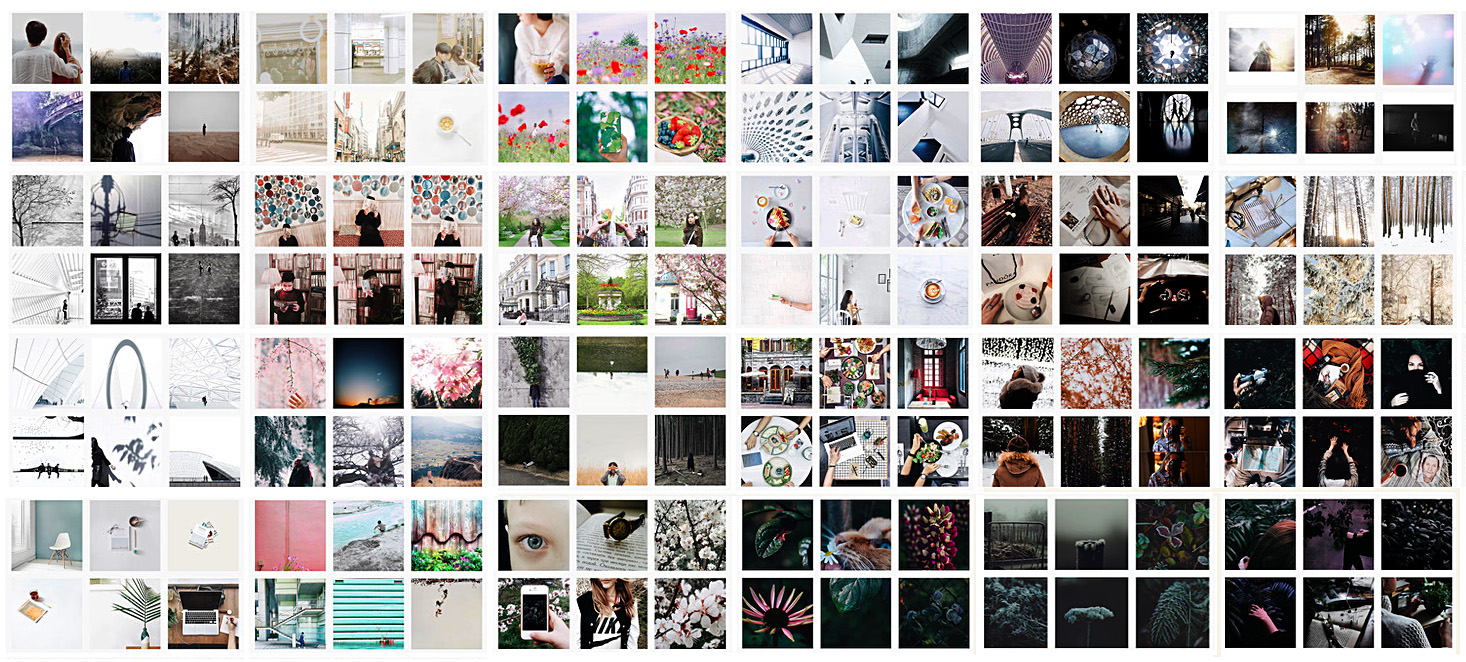
Instagram and Contemporary Image
Download final book (single PDF)
The four parts of the book were written between 12/20/2015 and 12/26/2016 and posted online as they were completed. The final version available as a single PDF combines revised versions of these chapters, an Introduction (written in August 2017 - essentially, it is a new chapter), and an Appendix. This version was released in September 2017. All text is available under Attribution-NonCommercial-NoDerivatives 4.0 International Creative Commons license.
Instagram and Contemporary Image - download complete book PDF (final version).
Book parts
These are the earlier versions of 4 book parts:
1. Subjects and Styles in Instagram Photography (Part 1)
2. Subjects and Styles in Instagram Photography (Part 2)
3 Instagrammism and contemporary cultural identity
4 Designing and Living Instagram Photography: Themes, Feeds, Sequences, Branding, Faces, Bodies
Translations
Following its release on the web in 2017, Instagram and Contemporary Image was translated and published in Japan, Brazil, and Italy.
Book description
Millions of people around the world today use digital tools and platforms to create and share sophisticated cultural artifacts. This book focuses on one such platform: Instagram. It places Instagram image culture within a rich cultural and historical context, including the histories of photography, cinema, graphic design, and social media, contemporary design trends, music videos, and k-pop. At the same time, it uses Instagram as a window into the identities of the first truly global generation connected by common social media platforms, programming languages, and visual aesthetics.
Manovich combines methods from art history, media studies, and data science, demonstrating in practice how humanistic close reading and computational analysis of large datasets can work together.
The book draws on a computational analysis of 16 million Instagram photos shared in 17 global cities since 2012. This data collection and analysis were performed in Manovich's Cultural Analytics Lab at the Qualcomm Institute (UCSD Division of the California Institute for Telecommunication and Information Technology).
Preface
Millions of people around the world today use digital tools and platforms to create and share sophisticated cultural artifacts. This book focuses on one such platform: Instagram. It places Instagram image culture within a rich cultural and historical context, including histories of photography, cinema, and graphic design, as well as contemporary social media, design trends, music video, and k-pop. At the same time, it uses Instagram as a window into the identities of a young global generation connected by common social media platforms, cultural sensibilities, and visual aesthetics.
My book is an experiment to see how we can combine traditional qualitative approaches of media theory and art history with quantitative analysis that uses “big cultural data” and computational methods. I am drawing on the analysis of 15 million images shared on Instagram in 16 global cities during 2012–2015 carried out in our Cultural Analytics Lab, publications from many other labs, my own informal observations from using Instagram for five years, and my direct observations of mobile phone photography cultures during 2010–2015 in 58 cities in 31 countries.
Media platforms such as Instagram continuously change during their histories. These changes include new filters, new features such as Insights, Stories, and Archive, new ways for advertisers to use the medium, changing capacities of cameras in mobile phones, etc. All of this affects the subjects and aesthetics of shared images. As the number of Instagram users grew from 30 million in 2012 to 300 million by the end of 2014, it became a valuable advertising and marketing medium. The number of Instagram advertisers increased from 200,000 in 2/2016 to one million in 3/2017. Over time, the strategies to create and run successful Instagram accounts have been identified and described in endless articles, blog posts, and videos.
The analysis in this book covers the period from early 2012 to the end of 2015 and the reader should not expect that all characteristics it describes remain unchanged after that. Instagram keeps modifying and expanding its platform, and its users also change their tactics. The period covered here includes both the time when most people used Instagram spontaneously without deliberate planning and the later period when the spontaneous and strategic uses coexisted.
My thinking about Instagram, social media, visual culture, the history of photography, and computational and visualization methods deeply benefited from interactions with a number of close collaborators: Alise Tifentale, Miriam Redi, Damiano Cerrone, Nadav Hochman, Damon Crockett, Jay Chow, and Mehrdad Yazdani. Thank you all very much!
